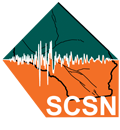The Southern California Seismic Network monitors ground motion from the U.S./Mexico border north to a line which passes approximately through San Luis Obispo and Big Pine. In order to increase station density within our boundaries or provide adequate coverage at the edges of the network, we also work closely with other monitoring groups sharing sites and data. Nearly all seismic networks assist each other, since all have the common goal in progressing toward a better future by mitigating seismic hazards.
The following numbers describe the current status of SCSN:
- Over 400 seismic stations owned and operated by SCSN (the CI network).
- Nearly 1000 channels imported and archived from these stations.
- Over 200 strong motion sensors (accelerometers) and over 350 velocity sensors in the CI network (many sites have both).
- Data imported from over 150 stations owned by 14 other networks in southern California, northern California, Nevada and Baja California.
SCSN works closely with the Northern California Seismic Network and other partners as part of the California Integrated Seismic Network (CISN). As a regional seismic network, we are also part of the Advanced National Seismic Network (ANSS).
The network has one of the fastest automated response times of any seismic network. Creating and maintaining the network involves challenges such as site selection criteria, station equipment (seismometers, data loggers, etc.), telemetry and data communications, automated processing and alerting.
Discover how SCSN has grown
Use the slider to investigate how the number and distribution of stations within the Southern California Seismic Network has changed over time. Clicking on the markers shows you the name of the one or more stations in the area (for simplicity stations have been grouped where they are closer than 10km from each other).
Also visit SCEDC to use their interactive station map.



